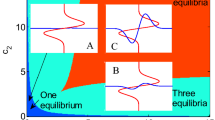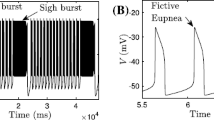Abstract
We studied the dynamical behavior of a class of compound central pattern generator (CPG) models consisting of a simple neural network oscillator driven by both constant and periodic inputs of varying amplitudes, frequencies, and phases. We focused on a specific oscillator composed of two mutually inhibiting types of neuron (inspiratory and expiratory neurons) that may be considered as a minimal model of the mammalian respiratory rhythm generator. The simulation results demonstrated how a simple CPG model— with a minimum number of neurons and mild nonlinearities— may reproduce a host of complex dynamical behaviors under various periodic inputs. In particular, the network oscillated spontaneously only when both neurons received adequate and proportionate constant excitations. In the presence of a periodic source, the spontaneous rhythm was overriden by an entrained oscillation of varying forms depending on the nature of the source. Stable entrained oscillations were inducible by two types of inputs: (1) anti-phase periodic inputs with alternating agonist-antagonist drives to both neurons and (2) a single periodic drive to only one of the neurons. In-phase inputs, which exert periodic drives of similar magnitude and phase relationships to both neurons, resulted in varying disruptions of the entrained oscillations including magnitude attenuation, harmonic and phase distortions, and quasi-periodic interference. In the absence of significant phasic feedback, chaotic motion developed only when the CPG was driven by multiple periodic inputs. Apneic episodes with repetitive alternation of active (intrinsic oscillation) and inactive (cessation of oscillation) states developed when the network was driven by a moderate periodic input of low frequency. %and amplitudes of intermediate strength, Similar results were demonstrated in other, more complex oscillator models (that is, half-center oscillator and three-phase respiratory network model). These theoretical results may have important implications in elucidating the mechanisms of rhythmogenesis in the mature and developing respiratory CPG as well as other compound CPGs in mammalian and invertebrate nervous systems.
Similar content being viewed by others
References
Aihara K, Matsumoto G (1986) Chaotic oscillations and bifurcations in squid giant axons. In: AV Holden, ed. Chaos. Princeton University Press, Princeton, NJ. pp. 257-269.
Alexander JC, Doedel EJ, Othmer HG (1990) On the resonance structure in a forced excitable system. SIAM J. Appl. Math. 50:1373-1418.
Arata A, Onimaru H, Homma I (1990) Respiration-related neurons in the ventral medulla of newborn rats in vitro. Brain Res. Bull. 24:599-604.
Balis UJ, Morris KF, Koleski J, Lindsey BG (1994) Simulations of a ventrolateral medullary neural network for respiratory rhythmogenesis inferred from spike train cross-correlation. Biol. Cybern. 70:311-327.
Barahona M, Poon C-S (1996) Detection of nonlinear dynamics in short, noisy time series. Nature 381:215-217.
Barrington KJ, Finer NN, Wilkinson MH (1987) Progressive shortening of the periodic breathing cycle duration in normal infants. Pediatr. Res. 21:247-251.
Bechbache RR, Duffin J (1977) The entrainment of breathing frequency by exercise rhythm. J. Physiol. 272:553-561.
Bergé P, Pomeau Y, Vidal C (1984) Order Within Chaos. Wiley, New York.
Bonham AC, Coles SK, McCrimmon DR (1993) Pulmonary stretch receptor afferents activate excitatory amino acid receptors in the nucleus tractus solitarii in rats. J. Physiol. 464:725-745.
Botros SM, Bruce EN (1990) Neural network implementation of a three-phase model of respiratory rhythm generation. Biol. Cybern. 63:143-153.
Bramble DM, Carrier DR (1983) Running and breathing in mammals. Science 219:251-256.
Canavier CC, Clark JW, Byrne JH (1990) Routes to chaos in a model of bursting neuron. Biophys. J. 57:1245-1251.
Carroll JL, Bamford OS, Fitzgerald RS (1993) Postnatal maturation of carotid chemoreceptor responses to O2 and CO2 in the cat. J. Appl. Physiol. 75:2383-2391.
Cohen M, Grossberg S, Pribe C (1992) A neural pattern generator that exhibits frequency-dependent in-phase and anti-phase oscillations. In: Conference on Neural Networks for Learning, Recognition and Control. Boston University, May 14-16, p. 32.
Collins JJ, Stewart I (1994) A group-theoretic approach to rings of coupled biological oscillators. Biol. Cybern. 71:95-103.
Corio M, Palisses R, Viala D (1993) Origin of the central entrainment of respiration by locomotion facilitated by MK 801 in the decerebrate rabbit. Exp. Brain Res. 95:84-90.
Cunningham DJC, Robbins PA, Wolff CB (1986) Integration of respiratory responses to changes in alveolar partial pressures of CO2and O2 and in arterial pH. In: NS Cherniack, JG Widdicombe, eds. Handbook of Physiology, Section 3: The Respiratory System, Control of Breathing, Part 2, American Physiological Society, Bethesda, MD., vol. II, pp. 475-528.
Cymbalyuk GS, Nikolaev RM, Borisyuk RM (1994) In-phase and anti-phase self-oscillation in a model of two electrically coupled pacemakers. Biol. Cybern. 71:153-160.
Delcomyn F (1980) Neural basis of rhythmic behavior in animals. Science 210:492-498.
Duffin J (1991) A model of respiratory rhythm generation. Neuroreport 2:623-626.
Duffin J, Douse MA (1993) Botzinger expiratory neurons inhibit propriobulbar decrementing inspiratory neurons. NeuroReport 4:1215-1218.
Duffin J, Ezure K, Lipski J (1995) Breathing rhythm generation: Focus on the rostral ventrolateral medulla. News in Physiol. Sci. 10:133-140.
Ermentrout GB (1982) n:m Phase-locking of weakly coupled oscillators. J. Math. Biology 12:327-342.
Ezure K, Manabe M (1986) An origin of inspiratory inhibition of expiratory neurons in the Botzinger complex. J. Physiol. Soc. Japan 48:384.
Friesen WO, Stent GS (1977) Generation of a locomotory rhythm by a neural network with recurrent cyclic inhibition. Biol. Cybern. 28:27-40.
Glass L, Mackey MC (1988). From Clocks to Chaos. Princeton University Press, Princeton, NJ.
Gottscchalk A, Geitz KA, Richter DW, Ogilvie MD, Pack AI (1992) Nonlinear Dynamics of a Model of the Central Respiratory Pattern Generator. In: Y Honda et al., eds. Control of Breathing and Its Modeling Perspective. Plenum Press, New York. pp. 51-55.
Gottschalk A, Ogilvie MD, Richter DW, Pack A (1994) Computational aspects of the respiratory pattern generator. Neural Computation 6:56-68.
Graves C, Glass L, Laporta D, Meloche R, Grassino A. (1986) Respiratory phase locking during mechanical ventilation in anesthetized human subjects. Am. J. Physiol. 250 (Regulatory, Integrative Comp. Physiol.19):R902-R909.
Guevara MR, Glass L (1982). Phase locking, period doubling bifurcations and chaos in a mathematical model of a periodically driven oscillator: A theory for the entrainment of biological oscillators and the generation of cardiac dysrhythmias. J. Math. Biology 14:1-23.
Guz A, Trenchard DW (1971) Pulmonary stretch receptor activity in man: A comparison with dog and cat. J. Physiol. London 213:329-343.
Haas F, Distenfeld S, Axen K (1986) Effects of perceived musical rhythm on respiratory pattern. J. Appl. Physiol. 61:1185-1191.
Hayashi F, Lipski J (1992) The role of inhibitory amino acids in control of respiratory motor output in an arterially perfused rat. Respir. Physiol. 89:47-63.
Henderson-Smart DJ, Cohen GL (1988) Chemical control of breathing in early life. In: PJ Schwartz, DP Southall, M Valdes-Dapena, eds. The Sudden Infant Death Syndrome. Annals of the New York Academy of Sciences, New York Academy of Sciences, New York, vol. 533, pp. 276-288.
Kalia M, Schweitzer P, Champagnat J, Denavit-Saubie M (1993) Two distinct phases characterize maturation of neurons in the nucleus of the tractus solitarius during early development: Morphological and electrophysiological evidence. J. Comp. Neurol. 327:18-36.
Kazanovich YB, Borisyuk RM (1994) Synchronization in a neural network of phase oscillators with central element. Biol. Cybern. 71:177-185.
Kholwadwala D, Donnelly DF (1992) Maturation of carotid chemoreceptor sensitivity to hypoxia: In vitro studies in the newborn rat. J. Physiol. (London) 453:461-473.
Khoo MCK, Kronauer RE, Strohl KP, Slutsky AS (1982) Factors inducing periodic breathing in humans: A general model. J. Appl. Physiol. 53:644-659.
Kinney HC, Filiano JJ, Sleeper LA, Mandell F, Valdes-Dapena M, White WF (1995) Decreased muscarinic receptor binding in the arcuate nucleus in sudden infant death syndrome. Science 269:1446-1450.
Kopell N (1988) Toward a theroy of modelling central pattern generators. In: AH Cohen, S Rossignol, S Grillner, eds. Neural Control of Rhythmic Movements. Wiley, New York. pp. 369-413.
Kopell N, Ermentrout GB (1988) Coupled oscillators and the design of central pattern generators. Math. Biosci. 90:87-109.
Lahiri S, Mei SS, Kao FF (1975) Vagal modulation of respiratory control during exercise. Respirat. Physiol. 23:133-146.
Matsugu M, Poon CS (1993) Estimation of information capacity in oscillatory neural networks. In: Proceedings of the International Joint Conference on Neural Networks, Nagoya, Japan. pp. 425-428.
Matsugu M, Poon CS (1997) Nonlinear Dynamics in a Compound Central Pattern Generator. In: Proceedings of the Fifth Annual Computational Neuroscience Meeting. Plenum Press, Boston.
Matsuoka K (1985) Sustained oscillations generated by mutually inhibiting neurons with adaptation. Biol. Cybern. 52:367-376.
Mifflin S, Ballantyne D, Backman S, Richter DW (1985) Evidence for a calcium activated potassium conductance in medullary respiratory neurons. In: Neurogenesis of Central Respiratory Rhythm. MTP Press, Lancaster. pp. 179-182.
Ogilvie MD, Gottschalk A, Anders K, Richter DW, Pack AI (1992) A network model of respiratory rhythmogenesis. Am. J. Physiol. 263:R962-R975.
Ostlund S, Rand D, Sethna D, Siggia E (1983) Universal properties of the transition from quasi-periodicity to chaos in dissipative sytems. Physica 8D:303-342.
Parker TS, Chua LO (1989) Practical Numerical Algorithms for Chaotic Systems. Springer-Verlag, New York. p. 80.
Petrillo GA, Glass A (1984) A theory for phase locking respiration in cats to a mechanical ventilator. Am. J. Physiol. 246 (Regulatory Integrative Comp. Physiol.15):R311-R320.
Phillipson EA (1986) Control of breathing during sleep. In: NS Cherniack, JG Widdicombe, eds. Handbook of Physiology, Section 3: The Respiratory System, Control of Breathing, Part 2, American Physiological Society, Bethesda, MD., vol. II, pp. 649-690.
Phillipson EA, Duffin J, Cooper JD (1981) Critical dependence of respiratory rhythmicity on metabolic CO2 load. J. Appl. Physiol. 50:45-54.
Pinsky PF, Rinzel J (1994) Intrinsic and network rhythmogenesis in a reduced Traub model for CA3 neurons. J. Comput. Neurosci. 1:39-60.
Poon C-S (1995) Respiratory models and control. In: HJ Chizeck, ed. Handbook of Biomedical Engineering, Section 15, Physiological Modeling, Simulation and Control. CRC Press, Boca Raton, FL. pp. 2404-2421.
Richter DW, Ballantyne D, Remmers JE (1986) How is the respiratory rhythm generated? A model. News Physiol. Sci. 1:109-112.
Richter DW, Ballanyi K, Schwarzacher S (1992) Mechanisms of respiratory rhythm generation. Curr. Opin. Neurobiol. 2:788-793.
Rinzel J, Ermentrout GB (1989) Analysis of neural excitability and oscillations. In: C. Koch, ed. Methods in Neuronal Modeling. MIT Press, Cambridge, MA. pp. 135-169.
Sammon MP, Bruce EN (1991) Vagal afferent activity increases dynamical dimension of respiration in rats. J. Appl. Physiol. 70:1748-1762.
Sammon MP, Darnall RA (1994) Entrainment of respiration to rocking in premature infants: coherence analysis. J. Appl. Physiol. 77:1548-1554.
Schweitzer P, Fortin G, Beloeil JC, Champagnat J (1992) In vitro study of newborn rat brain maturation: Implications for sudden infant death syndrome. Neurochem. International 20:109-112.
Selverston A, Mazzoni P (1989) Flexibility of computational units in invertebrate CPGs. In: R Durbin, C Miall, G Mitchison, eds. The Computing Neuron. Addison-Wesley, Reading, MA. pp. 205-228.
Sheridan MS, Kostlany E (1994) SIDS and chaos. Medical Hypothesis 42:11-12.
Skinner FK, Kopell N, Marder E (1994) Mechanisms for oscillation and frequency control in reciprocally inhibitory model neural networks. J. Comput. Neurosci. 1:69-88.
Smith JC (1996) Realistic computational models of respiratory neurons and networks. In: M Khoo, ed. Bioengineering Approaches to Pulmonary Physiology and Medicine. Plenum Press, New York. pp. 77-92.
Smith JC, Ellenberger K, Ballanyi D, Richter DW, Feldman JL (1991) Pre-Bötzinger complex: a brain stem region that may generate respiratory rhythm in mammals. Science 254:726-729.
Takahashi E, Tejima K, Tateishi I (1992) Synchronization of respiratory rhythm with mechanical ventilation by respiratory O2 oscillations in vagotomized dogs. In: T Honda, Y Miyamoto, K Konno, JG Widdicomb, eds. Control of Breathing and Its Modeling Perspectives. Plenum Press, New York. pp. 147-150.
Tomita K (1986) Periodically forced nonlinear oscillators. In: AV Holden, ed. Chaos. Princeton University Press, Princeton, NJ. pp. 257-269.
Vardhan A, Kachroo A, Sapru HN (1993) Excitatory amino acid receptors in the nucleus tractus solitarius mediate the responses to the stimulation of cardio-pulmonary vagal afferent C fiber endings. Brain Research 618:23-31.
Widdicombe JG (1961) Respiratory reflexes in man and other mammalian species. Clin. Sci. 21:163-170.
Author information
Authors and Affiliations
Corresponding author
Rights and permissions
About this article
Cite this article
Matsugu, M., Duffin, J. & Poon, CS. Entrainment, Instability, Quasi-periodicity, and Chaos in a Compound Neural Oscillator. J Comput Neurosci 5, 35–51 (1998). https://doi.org/10.1023/A:1008826326829
Issue Date:
DOI: https://doi.org/10.1023/A:1008826326829




